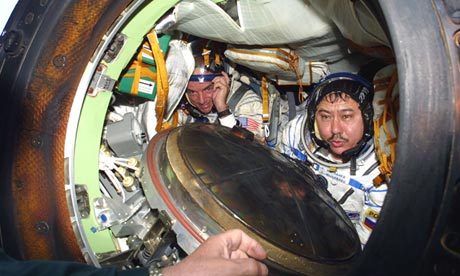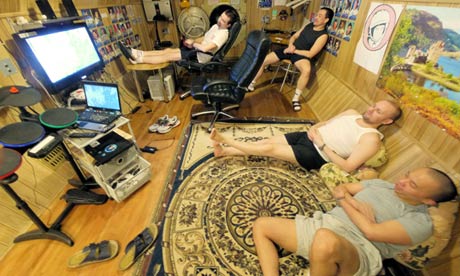Many of the most exciting discoveries in all fields of science are being played out in the human body
1 APPENDIX TO LIFE
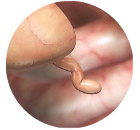
The appendix gets a bad press. It is usually treated as a body part that lost its function millions of years ago. All it seems to do is occasionally get infected and cause appendicitis. Yet recently it has been discovered that the appendix is very useful to the bacteria that help your digestive system function. They use it to get respite from the strain of the frenzied activity of the gut, somewhere to breed and help keep the gut's bacterial inhabitants topped up. So treat your appendix with respect.
2 SUPERSIZED MOLECULES
Practically everything we experience is made up of molecules. These vary in size from simple pairs of atoms, like an oxygen molecule, to complex organic structures. But the biggest molecule in nature resides in your body. It is chromosome 1. A normal human cell has 23 pairs of chromosomes in its nucleus, each a single, very long, molecule of DNA. Chromosome 1 is the biggest, containing around 10bn atoms, to pack in the amount of information that is encoded in the molecule.
3 ATOM COUNT
It is hard to grasp just how small the atoms that make up your body are until you take a look at the sheer number of them. An adult is made up of around 7,000,000,000,000,000,000,000,000,000 (7 octillion) atoms.
4 FUR LOSS
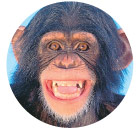
It might seem hard to believe, but we have about the same number of hairs on our bodies as a chimpanzee, it's just that our hairs are useless, so fine they are almost invisible. We aren't sure quite why we lost our protective fur. It has been suggested that it may have been to help early humans sweat more easily, or to make life harder for parasites such as lice and ticks, or even because our ancestors were partly aquatic.
But perhaps the most attractive idea is that early humans needed to co-operate more when they moved out of the trees into the savanna. When animals are bred for co-operation, as we once did with wolves to produce dogs, they become more like their infants. In a fascinating 40-year experiment starting in the 1950s, Russian foxes were bred for docility. Over the period, adult foxes become more and more like large cubs, spending more time playing, and developing drooping ears, floppy tails and patterned coats. Humans similarly have some characteristics of infantile apes – large heads, small mouths and, significantly here, finer body hair.
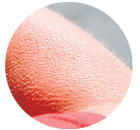
Goosepimples are a remnant of our evolutionary predecessors. They occur when tiny muscles around the base of each hair tense, pulling the hair more erect. With a decent covering of fur, this would fluff up the coat, getting more air into it, making it a better insulator. But with a human's thin body hair, it just makes our skin look strange.
Similarly we get the bristling feeling of our hair standing on end when we are scared or experience an emotive memory. Many mammals fluff up their fur when threatened, to look bigger and so more dangerous. Humans used to have a similar defensive fluffing up of their body hairs, but once again, the effect is now ruined. We still feel the sensation of hairs standing on end, but gain no visual bulk.
6 SPACE TRAUMA
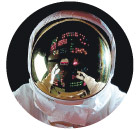
If sci-fi movies were to be believed, terrible things would happen if your body were pushed from a spaceship without a suit. But it's mostly fiction. There would be some discomfort as the air inside the body expanded, but nothing like the exploding body parts Hollywood loves. Although liquids do boil in a vacuum, your blood is kept under pressure by your circulatory system and would be just fine. And although space is very cold, you would not lose heat particularly quickly. As Thermos flasks demonstrate, a vacuum is a great insulator.
In practice, the thing that will kill you in space is simply the lack of air. In 1965 a test subject's suit sprang a leak in a Nasa vacuum chamber. The victim, who survived, remained conscious for around 14 seconds. The exact survival limit isn't known, but would probably be one to two minutes.
7 ATOMIC COLLAPSE
The atoms that make up your body are mostly empty space, so despite there being so many of them, without that space you would compress into a tiny volume. The nucleus that makes up the vast bulk of the matter in an atom is so much smaller than the whole structure that it is comparable to the size of a fly in a cathedral. If you lost all your empty atomic space, your body would fit into a cube less than 1/500th of a centimetre on each side. Neutron stars are made up of matter that has undergone exactly this kind of compression. In a single cubic centimetre of neutron star material there are around 100m tons of matter. An entire neutron star, heavier than our sun, occupies a sphere that is roughly the size across of the Isle of Wight.
8 ELECTROMAGNETIC REPULSION
The atoms that make up matter never touch each other. The closer they get, the more repulsion there is between the electrical charges on their component parts. It's like trying to bring two intensely powerful magnets together, north pole to north pole. This even applies when objects appear to be in contact. When you sit on a chair, you don't touch it. You float a tiny distance above, suspended by the repulsion between atoms. This electromagnetic force is vastly stronger than the force of gravity – around a billion billion billion billion times stronger. You can demonstrate the relative strength by holding a fridge magnet near a fridge and letting go. The electromagnetic force from the tiny magnet overwhelms the gravitational attraction of the whole Earth.
9 STARDUST TO STARDUST

Every atom in your body is billions of years old. Hydrogen, the most common element in the universe and a major feature of your body, was produced in the big bang 13.7bn years ago. Heavier atoms such as carbon and oxygen were forged in stars between 7bn and 12bn years ago, and blasted across space when the stars exploded. Some of these explosions were so powerful that they also produced the elements heavier than iron, which stars can't construct. This means that the components of your body are truly ancient: you are stardust.
10 THE QUANTUM BODY
One of the mysteries of science is how something as apparently solid and straightforward as your body can be made of strangely behaving quantum particles such as atoms and their constituents. If you ask most people to draw a picture of one of the atoms in their bodies, they will produce something like a miniature solar system, with a nucleus as the sun and electrons whizzing round like planets. This was, indeed, an early model of the atom, but it was realised that such atoms would collapse in an instant. This is because electrons have an electrical charge and accelerating a charged particle, which is necessary to keep it in orbit, would make it give off energy in the form of light, leaving the electron spiralling into the nucleus.
In reality, electrons are confined to specific orbits, as if they ran on rails. They can't exist anywhere between these orbits but have to make a "quantum leap" from one to another. What's more, as quantum particles, electrons exist as a collection of probabilities rather than at specific locations, so a better picture is to show the electrons as a set of fuzzy shells around the nucleus.
11 RED BLOODED
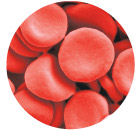
When you see blood oozing from a cut in your finger, you might assume that it is red because of the iron in it, rather as rust has a reddish hue. But the presence of the iron is a coincidence. The red colour arises because the iron is bound in a ring of atoms in haemoglobin called porphyrin and it's the shape of this structure that produces the colour. Just how red your haemoglobin is depends on whether there is oxygen bound to it. When there is oxygen present, it changes the shape of the porphyrin, giving the red blood cells a more vivid shade.
12 GOING VIRAL
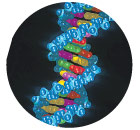
Surprisingly, not all the useful DNA in your chromosomes comes from your evolutionary ancestors – some of it was borrowed from elsewhere. Your DNA includes the genes from at least eight retroviruses. These are a kind of virus that makes use of the cell's mechanisms for coding DNA to take over a cell. At some point in human history, these genes became incorporated into human DNA. These viral genes in DNA now perform important functions in human
reproduction, yet they are entirely alien to our genetic ancestry.
13 OTHER LIFE
On sheer count of cells, there is more bacterial life inside you than human. There are around 10tn of your own cells, but 10 times more bacteria. Many of the bacteria that call you home are friendly in the sense that they don't do any harm. Some are beneficial.
In the 1920s, an American engineer investigated whether animals could live without bacteria, hoping that a bacteria-free world would be a healthier one. James "Art" Reyniers made it his life's work to produce environments where animals could be raised bacteria-free. The result was clear. It was possible. But many of Reyniers's animals died and those that survived had to be fed on special food. This is because bacteria in the gut help with digestion. You could exist with no bacteria, but without the help of the enzymes in your gut that bacteria produce, you would need to eat food that is more loaded with nutrients than a typical diet.
14 EYELASH INVADERS

Depending on how old you are, it's pretty likely that you have eyelash mites. These tiny creatures live on old skin cells and the natural oil (sebum) produced by human hair follicles. They are usually harmless, though they can cause an allergic reaction in a minority of people. Eyelash mites typically grow to a third of a millimetre and are near-transparent, so you are unlikely to see them with the naked eye. Put an eyelash hair or eyebrow hair under the microscope, though, and you may find them, as they spend most of their time right at the base of the hair where it meets the skin. Around half the population have them, a proportion that rises as we get older.
15 PHOTON DETECTORS
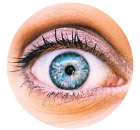
Your eyes are very sensitive, able to detect just a few photons of light. If you take a look on a very clear night at the constellation of Andromeda, a little fuzzy patch of light is just visible with the naked eye. If you can make out that tiny blob, you are seeing as far as is humanly possible without technology. Andromeda is the nearest large galaxy to our own Milky Way. But "near" is a relative term in intergalactic space – the Andromeda galaxy is 2.5m light years away. When the photons of light that hit your eye began their journey, there were no human beings. We were yet to evolve. You are seeing an almost inconceivable distance and looking back in time through 2.5m years.
16 SENSORY TALLY
Despite what you've probably been told, you have more than five senses. Here's a simple example. Put your hand a few centimetres away from a hot iron. None of your five senses can tell you the iron will burn you. Yet you can feel that the iron is hot from a distance and won't touch it. This is thanks to an extra sense – the heat sensors in your skin. Similarly we can detect pain or tell if we are upside down.
Another quick test. Close your eyes and touch your nose. You aren't using the big five to find it, but instead proprioception. This is the sense that detects where the parts of your body are with respect to each other. It's a meta-sense, combining your brain's knowledge of what your muscles are doing with a feel for the size and shape of your body. Without using your basic five senses, you can still guide a hand unerringly to touch your nose.
17 REAL AGE
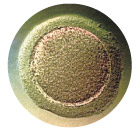
Just like a chicken, your life started off with an egg. Not a chunky thing in a shell, but an egg nonetheless. However, there is a significant difference between a human egg and a chicken egg that has a surprising effect on your age. Human eggs are tiny. They are, after all, just a single cell and are typically around 0.2mm across – about the size of a printed full stop. Your egg was formed in your mother – but the surprising thing is that it was formed when she was an embryo. The formation of your egg, and the half of your DNA that came from your mother, could be considered as the very first moment of your existence. And it happened before your mother was born. Say your mother was 30 when she had you, then on your 18th birthday you were arguably over 48 years old.
18 EPIGENETIC INFLUENCE
We are used to thinking of genes as being the controlling factor that determines what each of us is like physically, but genes are only a tiny part of our DNA. The other 97% was thought to be junk until recently, but we now realise that epigenetics – the processes that go on outside the genes – also have a major influence on our development. Some parts act to control "switches" that turn genes on and off, or program the production of other key compounds. For a long time it was a puzzle how around 20,000 genes (far fewer than some breeds of rice) were enough to specify exactly what we were like. The realisation now is that the other 97% of our DNA is equally important.
19 CONSCIOUS ACTION

If you are like most people, you will locate your conscious mind roughly behind your eyes, as if there were a little person sitting there, steering the much larger automaton that is your body. You know there isn't really a tiny figure in there, pulling the levers, but your consciousnessseems to have an independent existence, telling the rest of your body what to do.
In reality, much of the control comes from your unconscious. Some tasks become automatic with practice, so that we no longer need to think about the basic actions. When this happens the process is handled by one of the most primitive parts of the brain, close to the brain stem. However even a clearly conscious action such as picking up an object seems to have some unconscious precursors, with the brain firing up before you make the decision to act. There is considerable argument over when the conscious mind plays its part, but there is no doubt that we owe a lot more to our unconscious than we often allow.
20 OPTICAL DELUSION
The picture of the world we "see" is artificial. Our brains don't produce an image the way a video camera works. Instead, the brain constructs a model of the world from the information provided by modules that measure light and shade, edges, curvature and so on. This makes it simple for the brain to paint out the blind spot, the area of your retina where the optic nerve joins, which has no sensors. It also compensates for the rapid jerky movements of our eyes called saccades, giving a false picture of steady vision.
But the downside of this process is that it makes our eyes easy to fool. TV, films and optical illusions work by misleading the brain about what the eye is seeing. This is also why the moon appears much larger than it is and seems to vary in size: the true optical size of the moon is similar to a hole created by a hole punch held at arm's length.
















